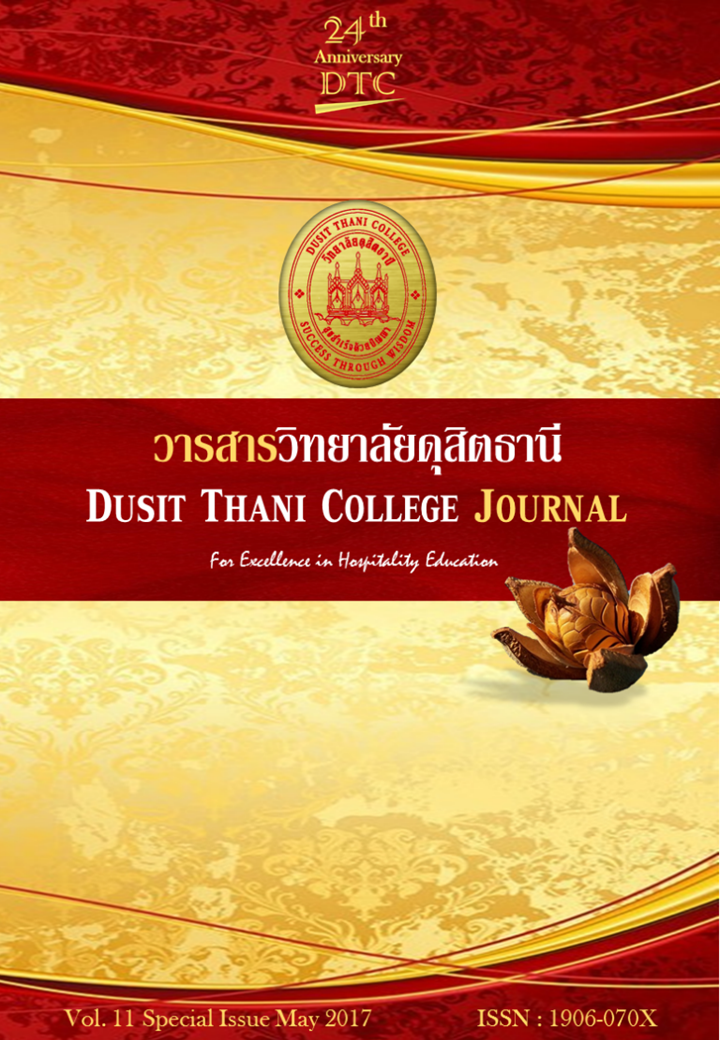Lifestyle Segmentation: A Case Study of Student of Dusit Thani College
Main Article Content
Abstract
This research aims to investigate the psychographic segmentation of student of Dusit Thani College to classify the mainly student’s lifestyle by integrating the demographic factors of Bangkok and Pattaya campus, and to suggest the instructors and administrators adjust the teaching style and formulating strategies to suitable the student’s lifestyle based on values and lifestyles or VALS framework. The respondents included 400 students included major of hotel and resort management, culinary arts and kitchen, tourism management, and MICE and events. The data collected through a survey, and used the exploratory factor analysis (EFA), cluster analysis, discriminant analysis (DA), and correspondence analysis (CA) to classify the lifestyle. Consequently, the major, campus, and GPA can be classified the six main lifestyles included confidentist, nerd, planer, introvert, activist, and followers.
Article Details
Article Screening Policy
- All research and academic articles to be published must be considered and screened by three peer reviews in the relevant field / article.
- All articles, texts, illustrations and tables published in the journal are the personal opinions of the authors. Editors don't always have to agree. And no responsibility whatsoever is the sole responsibility of the author.
- The articles to be published must never be published. Where did you first publish? And not in the consideration of other journals If the audit found that there has been a duplicate publication It is the sole responsibility of the author.
- Any article that the reader sees as being plagiarized or impersonated without reference. Or mislead the work of the author Please let the journal editor know it will be your greatest blessing.
References
Boonme, J. (2016). Tourism Staff Development Using Service Mind Concept to Enhance Service Quality and Quality of Life. College of Hospitality and Tourism, Rajamangala University of Technology Srivijaya, Trang Campus
Ciribeli, J. B., & Miquelito, S. (2013). Market Segmentation by Psychographic Criteria: An Essay on the Main Psychographic Theoretical Approaches and its Relationship with Performance Criteria. Visión de Futuro, 12, 9, 51 - 64
Douglas, M. (1978). Cultural Bias. Occasional Paper no. 35, Royal Anthropological Institute of Great Britain and Ireland.
Dusit Thani College. (2015). Academic Programs. Retrieved October 5, 2016, from http://www.dtc.ac.th/en/academic-programs.html
George, D., & Mallery, P. (2003). SPSS for Windows step by step: A simple guide and reference. 11.0 update (4th ed.). Boston: Allyn & Bacon.
Ghosh, I. (2014). VALS™ Psychographic: A New Way of Market Segmentation in India. The International Journal of Business & Management, 2(4), 25 - 30.
Gliem, R.R., & Gliem, A. J. (2003). Calculating, Interpreting, and Reporting Cronbach’s Alpha Reliability Coefficient for Likert-Type Scales. 2003 Midwest Research to Practice Conference in Adult, Continuing, and Community Education, 82 – 88.
Gonzalez, A. and Bello, L. (2002). The Construct “Lifestyle” in Market Segmentation: The Behavior of Tourist Consumers”, European Journal of Marketing, 36, 51-85.
Hanspal, S. (2001). Advertising and Marketing Strategies: A Lifestyle approach; New Century Publication, Delhi; 4-78.
Ho, R. (2014). Handbook of Univariate and Multivariate Data Analysis and Interpretation with SPSS: Chapman \\& Hall/CRC.
Kongkachuichay, S., & Kaewwongsiri, M. (2011). A Study of Student’s Lifestyles at Faculty of Home Economics Technology Rajamangala University of Technology Phra Nakhon. Research, Rajamangala University of Technology Phra Nakhon.
Limeira, M. V. (2008). Comportamento do consumidor brasileiro. São Paulo: Saraiva
Mandhlazi L. (2012). Decision Making Styles of Generation Y Consumers in The Purchase of Fashion Apparel in Kempton Park. Marketing Doctoral Thesis. Vaal University of Technology.
Mitchell, A. (1983). The Nine American Lifestyles: Who We Are and Where We’re Going, Warner Books, New York.
Mitchell, V. W. (1994). How to Identify Psychographic Segments: Part 2. Marketing Intelligence and Planning, 12 (7), 11 – 17.
Novak, T.P., & MacEvoy B. (1990). “On Comparing Alternative Segmentation Schemes: The List of Values (LOV) and Values and Life Styles (VALS). Journal of consumer Research, 18, 105-9.
Office of the Permanent Secretary, Ministry of Tourism & Sports. (2015). Tourism Economic Review. Retrieved October 5, 2016, from http://www.mots.go.th/ewt_dl_link.php?nid=7533
Ratanavilaisakul, R. (2000). A study Student Lifestyles at King Mongkut's University of Technology Thonburi. KMUTT Research and Development Journal, 23(2), 95 - 114.
Riche, M.F. (1989). Psychographics for the 1990s; American Demographic, 24-26, 30-31, 53.
Sakworawich, A. (2016). Can universities in Thailand will survive?. Retrieved from http://www.manager.co.th/Daily/ViewNews.aspx?NewsID=9590000051896
Sarli, A., & Tat, H. H. (2011). Attracting Consumers by Finding out Their Psychographic Traits. International Journal of Fundamental Psychology & Social Sciences, 11(1), 6 - 10.
Somasri, P. (2013). A Study of Undergraduate Student’s Lifestyle at Srinakharinwirot University. Graduate School, Srinakharinwirot University.
Strategic Business Insights (2017). Retrieved from http://www.strategicbusinessinsights.com/vals/presurvey.shtml
Tanchisak, K. (2016). Business Research Methodology. Bangkok: Danex Interoperation.
TAGB: Thai Association of Governing Boards of Universities and Colleges. (2014). Retrieved October, 2016, Retrieved from https://tagbth.wordpress.com/ Thai Association of Governing Boards of Universities and Colleges
Thomas, P. N., & Bruce, M. (1990). On Comparing Alternative Segmentation Schemes: The List of Values (LOV) and Values and Lifestyles (VALS). Journal of Consumer Research, 17(1), 105-109.
Valentine, D., & Powers, T. (2013). Generation Y values and lifestyle segments. Journal of Consumer Marketing, 30(7), 597-606. doi: 10.1108/jcm-07-2013-0650
Vaidya, I. N. (2015). Lifestyle Based Segmentation of Rural Consumers of Central Gujarat: An Empirical Study with Special Reference To Gender And Age. IOSR Journal of Business and Management, 17(1), 33 - 41. doi: 10.9790/487x-17713341
Vasseur, V., & Kemp, R. (2015). A segmentation analysis: the case of photovoltaic in the Netherlands. Energy Efficiency, 8(6), 1105-1123. doi: 10.1007/s12053-015-9340-8
Wells, W. D. (1975). Psychographics: A Critical Reviews. Journal of Marketing Research, 12(May), 196-213.


